“Remembrance” : NDP 2015@Bukit Brown
Time: Between 8am and 7.30pm
Meeting Point: Various.
Remembrance Ceremony : 6.30 pm to 7.30pm @Block 1, as you enter on your right of new access road, you can’t miss us. We have flags!
This NDP 2015 @Bukit Brown, we remember and pay tribute to the space that embraces the touch stones of our memory, 100,000 tombstones. 100,000 lives; from Coolies to Community leaders, Paupers to Poets, Social Reformers to Socialites with a cause.
Bukit Brown is a microcosm of life at the turn of the 20 century – a collective narrative of hardship, struggle and triumph against the odds. So come celebrate Remembrance and lest we forget, we will remember the victims of war and our war heroes in this, the 70th anniversary of Liberation from Occupation with 2 walks from outside Bukit Brown leading to Bukit Brown. There will also be 2 guided walks within Bukit Brown starting in the late afternoon.
There have been drastic physical changes to the landscape since we started commemorating our Nations Deceased Pioneers (NDP) @ Bukit Brown in 2012. We lost the roundabout, then the ‘ole raintree and by 9th August 2015, the old road to Bukit Brown will be closed and a new road a few meters away is slated to open. But we endure and we will remember.
So join us for a simple commemoration, simple food, but rich stories. Look out for registration details for 3 walks on peatix which will be forthcoming at the end of this week 25/26 July, 2015. But available now for registration is:
1) NDP Guided Walk : Former Rail Corridor to Bukit Brown
Please register here
Facebook page here
Starting 8am – eta @Bukit Brown 4pm Meeting point is Kranji MRT station
“Join us as we start walking from Kranji MRT, down the former rail corridor, past Rail Mall, along Rifle Range Road, into MacRitchie Reservoir, and finally into Bukit Brown.
There will be a toilet break at Ten Mile Junction (approx 7km Walk)
There will be a lunch break at Rail Mall (approx 10Km Walk)
There will be activities planned in Bukit Brown as we celebrate National Day in a unique way.
As the entire walking distance is about 20km, participants are advised to:
– wear comfortable clothes, and walking shoes
– bring a cap / hat, in case of sun
– bring an umbrella / raincoat, in case of rain
– bring insect repellent / spray, in case of bites
– snacks, in case you go hungry …
– WATER WATER WATER
Looking forward to seeing you all on National Day!” From Keng Kiat and Beng Tang, your volunteer guides on this long walk.
================================================
2) NDP Guided Walk : Heritage Walk: From Singapore Botanic Gardens to Bukit Brown Cemetery
Join Simone and Bianca on a walk through the heritage lane, starting from the Botanic Gardens to Bukit Brown Cemetery. The Brownie ladies will share stories of WW2 heroes and prominent personalities at heritage landmarks, including the Jacob Ballas garden, the old Raffles College and the old Command House. The trail continues into Bukit Brown cemetery while we explore remnants and stories of the ‘kampung’ life that was once there
—————————————————————————
This guided walk starts at 3.30pm at Botanic Gardens MRT and we will end the walk near the entrance of Bukit Brown Cemetery, in time for the Remembrance Ceremony at 6.30pm. http://bukitbrown.com/main/?p=10040
Meeting Point: Botanic Gardens MRT Exit at ground level (near Cluny Court). We will be holding a sign to identify ourselves.
————————————————————————-
We’ll be walking on paved roads as well as trekking through the jungle so make sure you wear proper outfit for a light jungle trek. There are no bathrooms along the way and no places to buy water, so make sure you bring some snacks and drinks along and visit the bathroom before we start. And apply the mosquito repellent!
Sign up on Peatix:
3) “Founding Fathers” Guided Walk with Fabian Tee @ 4pm
Join Fabian as he shares stories on the lives and times of :Founding Fathers” of revolution and reform, in honour and humility. and #lestweforget those who perished in WW2.
Please register on peatix here
4) Mandarin Guided Walk with Yik Han @ 4pm
由Yik Han负责的华语导览将介绍几位安葬在武吉布朗坟场,来
集合地点:坟场正门(即Lorong Halwa入口处)
==========================
报名:
请在我们的Facebook活动页面按‘参加’/
—————————————————————————
3) and 4) guided walks start at 4.00pm and ends at 6.30 pm at Block 1.
Meeting Point: Bukit Brown entrance at new access road parallel to former entrance at Lorong Halwa
All participants to NDP 2015@ Bukit Brown will receive a World Monument Fund watch day bag while stocks last, and light snacks and water will be provided at the Remembrance ceremony.Watch this space for details of the other walks! Please register when its up, to help us prepare enough food and drink and minimise wastage. Our pioneers do would not approve of wastage!
The Way We Were:
The Battlefield tour
Sunday 19 July ’15, 9.30am – 11.30 am
Meeting point is at the pedestrian bridge on Sime Road entering Bukit Brown, opposite the SICC traffic light.
Please bring umbrella or poncho / sun block / mosquito repellent.
Please wear covered footwear.
Please register for a free tickets and more important information Here
Update: For the latest on which library the exhibition has moved to please click on this FB page link
Becoming Bishan: A Heritage Exhibition
What is Bishan? A concrete jungle of million-dollar HDB flats? The futuristic, award-winning architecture of SkyHabitat and Bishan Library? Or even the bustling activity of Junction 8? These are the conventional perceptions of the young, vibrant town of Bishan – an ex-cemetery transformed into a heartland showpiece.
Our team, however, felt that there just had to be more to this rising area. Whether we were lifelong residents of the district or saw it as a mere part of our daily commute to school, we became increasingly curious about how this place came to be. Why was there even a cemetery in Bishan in the first place? Did people live in Bishan before the HDB flats were built? What was Bishan’s place in the Singapore Story?
Driven by overwhelming curiosity, we, in conjunction with the Raffles Archives and Museum, embarked upon the Becoming Bishan Project, hoping that the outcomes of our research would be able to provide a poignant contribution to our country’s jubilee celebrations.
Our first step was to analyse the development of Bishan through maps. One of our members, Yilun, is an avid map enthusiast with an especial interest in urban redevelopment. With gusto, he surfaced many old maps of the area, the oldest dating back to 1924. Through painstaking effort, he managed to highlight the stark changes in the landscape of the area, as well as match old landmarks of the area to more familiar present-day ones. The topographical studies revealed many details about the geography of the Bishan area. Today, the land that makes up Bishan is rather flat. However, the contours of old maps suggest that pre-redevelopment,
Bishan was covered by rolling hills. Many photographs also show the grave-covered hills with the HDB flats of Toa Payoh in the background. This explains the how the name “Bishan” (“Jade Hills” in Mandarin) came about. One of our interviewees even compared the view from a Toa Payoh flat to a green dragon, because of the undulating hills and the scale-like tombs on them.
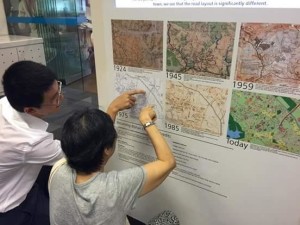
The highlight is a series of maps of Bishan tracing the landscape of changes from 1924 to the present (Photo RI Student Project Team)
There were several kampongs within the cemetery, the most notable one being Kampong San Teng, whose kampong association members still meet regularly today. Interviews with the old residents revealed a rather self-sufficient community, with a school, farms, a teahouse and a market. There was also a cinema, Nam Kok cinema, in the Bishan area that screened Chinese and Western films. A worker in the KPT coffee shop in Bishan North told us of how he used to work there, proudly showing us his old posters of Elvis Presley and actors from Hong Kong. But when we asked about people’s impressions of Bishan before redevelopment, the greatest fears were not ghosts and spirits, but secret society activity.
We also made several exciting discoveries along our research journey. One was that Bishan was once a World War II battlesite! Jon Cooper, who also runs the Bukit Brown battlefield tours, managed to surface the battalion diaries and hand-drawn maps of the Second Cambridgeshire Regiment. These documented the action at Braddell Road in the dying days of the Battle for Singapore (1942). Further research revealed that the battle positions occupied by the British troops are the present-day locations of Junction 8 shopping mall, Bishan Library and Raffles Institution. This story was corroborated by many residents, who recalled the sounds of gunfire through the rolling hills of Bishan. Another revelation we made was that the philanthropist Wong Ah Fook was once buried in the Peck San Theng cemetery and his ashes now lie in the columbarium, something that even those running the columbarium had been unaware of.
Along the way, our team has also met and befriended many diverse characters, who each have their own personal stake in Bishan. From the intriguing Mr. Molay, a Cantonese-speaking Indian man whose father once owned a hundred cows in Bishan, to the unabashed Mr. Loh, who once ate human flesh to survive the deprivation of the Japanese Occupation, it is the stories of these people who make the Bishan Story come alive. We thoroughly enjoyed the opportunity to talk to these individuals and learn more about the almost-foreign land that is the past. Later, we also spoke to current residents who told us about their thoughts and memories about this place. Though it is hard to say that the HDB dwellers of today have the same community spirit as kampong residents did, it was interesting to note how people develop, or fail to develop, attachments to Bishan.

Visitors to the exhibition have a chance to listen in on their memories of Bishan as a cemetery and its social community life then (photo RI Project Team)n
We feel immensely privileged to have had the experience of exploring Bishan’s story and curating this exhibition, and hope that you might find meaning of your own in our fruits of labour and love.
The Becoming Bishan exhibition will be officially launched on 11 July (Saturday), from 9 am – 12 noon, at the Bishan Community Library. This event will be graced by Senior Minister of State Josephine Teo. The exhibition will run at the Bishan Community Library from 1 July to 23 August, Ang Mo Kio Public Library from 24 August to 30 September and Toa Payoh Public Library from 1 to 31 October.
This is a student project from Raffles Institution, as part of the South cluster schools’ contribution to the SG50 celebration efforts.
This blog post is a team contribution from the students of Raffles Institution involved in Becoming Bishan.
atBB reviews:
atBB visited the exhibition and we are struck by the sheer breath of the history and heritage the students have been able to uncover of Bishan and how it has evolved into what it is today. From the old to the modern, the curated posters capture more than a snap shot, but with carefully chosen quotes, it has emotional resonance such that, one can be transported to a different time and space in Singapore.
Of particular interest was the coverage on how the community coped with WW 2 and provided refuge for other residents in other areas in war torn Singapore.
The exhibits on WW II was an eye opener with artefacts from both Japanese and British sides.
Augmented with video recordings of residents interviewed makes this exhibition a exemplar template for exhibitions on other neighbourhoods to emulate. Accompanying the exhibition is a pictorial booklet which value adds the exhibition and makes for a treasured keep sake for those interested in history and heritage and the transition to the modern.
atBB has been following the development of this project since the students first approached us for help in understanding cemetery culture and symbolism. We are proud to have made a small contribution to this project and have to say that full credit go to the students for taking it so far from when they first began. Congratulations and well done!
Mdm Chng of the Pang Family – A Mother of Journalists, Educationists and Revolutionaries
by Ang Yik Han
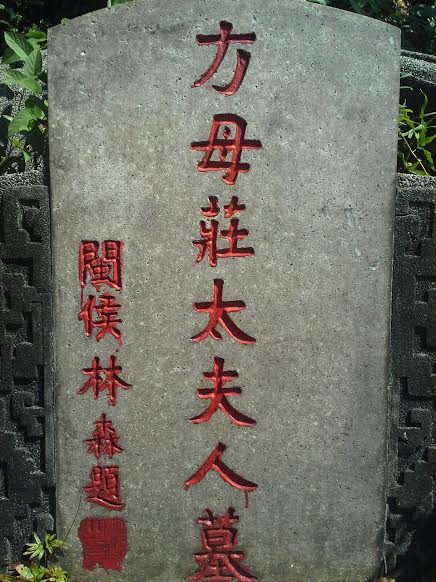
The tombstone of Mdm Chng, who died in 1936 at the age of 77. The characters on the tombstone were written by Lin Sen, KMT Chairman. (photo Yik Han)
Located at Hill 4 in Bukit Brown, the Teochew style tomb of Mdm Chng of the Pang family (方母莊太夫人) is simple and nondescript. A sharp-eyed observer will notice however that the calligraphy on the tombstone came from the hand of Lin Sen (林森), Chairman, of the ruling pre war Nationalist government in China.
Another sign of her family’s close connection to the Kuomintang was the fact in her obituary in the Nanyang Siang Pau, she was described as the mother of a martyr. This was in reference to her second son, Pang Nam Gang (方南岡), whose story was recorded in Feng Ziyou’s “Anecdotal History of the Revolution《革命逸史》” published in 1948.
Although two of Mdm Chng’s sons passed away before her, the names of all her sons were inscribed on her grave: Siao Cheok少石 (deceased), Nam Gang 南岡 (matyred), Chee Dong 之 棟, Huai Nam 懷南, Chee Cheng 之楨. Also present were the names of two daughters, though her obituary only mentioned one surviving daughter.
Pang Nam Gang had a good grounding in classical Chinese education. However, he spurned the traditional path of becoming a mandarin and chose to pursue his studies in Japan. There, he joined the Tongmenghui. Deeply committed to overthrowing Manchu rule, he devoted his time outside of studies to learning how to make bombs.
In 1905, Pang and eleven of his compatriots in Japan were ordered by Sun Yat-Sen to return to China to assist in the Huang Gang uprising in the Teochew region. Injured while preparing bombs, he was brought to Hong Kong and hospitalised, hence missed out on the action. When the uprising petered out, Pang decided to join his uncle who was a local governor in Gansu, with the intention of seeking opportunities to incite the local Hui people to rise against the Qing. His uncle was initially pleased to see his nephew, but flew into a rage when word reached him that Pang was a revolutionary. Locked up by his uncle, Pang escaped with the help of other relatives, stealing two horses and riding to Hankou, where he sold the horses and boarded ship for Japan to continue his studies. Eventually, he made his way to Penang where he became the editor of the Kwang Wah Yit Poh newspaper which was linked to the Tongmenghui.
The young revolutionary could not sit still for long. When news of the successful 1911 uprising in Wuhan reached the Nanyang, Pang rushed back to China where he raised a fighting force in his home county of Pho Leng. When Yuan Shikai was elected the first President of the nascent Chinese Republic, Pang felt that Yuan could not be trusted as he had too many links with the old regime. Disgruntled, he returned to Penang where he took up his old job at the newspaper.
Pang’s worst fears came true in 1915 when Yuan Shikai assumed the title of Emperor. This time, he could no longer abide the situation and returned to China again to fan the flames of revolution. Unfortunately, he was captured in Macau by Yuan Shikai’s agents and smuggled across the border and imprisoned. At first, he assumed a false identity and did not divulge any information even under torture. However, his fervent preaching of revolutionary ideas to his fellow prisoners gave him away and he was summarily executed. So perished a martyr of the Chinese Revolution at the age of 29.

Photo of Pang Nam Gang (reproduced from the book “The Teochews in Penang: A Concise History” by Mr Tan Kim Hong)
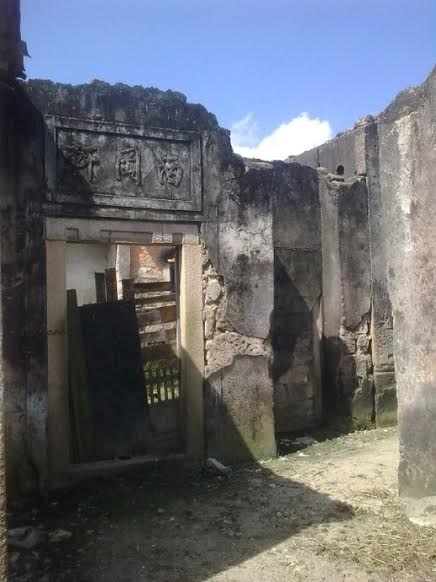
The house of Pang Nam Gang in Pho Leng (taken from the site 方益森的博客 http://blog.sina.com.cn/s/blog_756c1ab90101ipv2.html)
Mdm Chng’s obituary also mentioned that her three surviving sons were active in the areas of journalism, education and social works. Her youngest son, Pang Chee Cheng (方之楨), was in the limelight as well for his involvement in politics. A journalist, he was a KMT cadre who actively canvassed support for the party as one of the main committee members of the Nanyang branch headquarters.
In 1930, Sir Cecil Clementi became the Governor of the Straits Settlements. He had a dislike of the KMT due to its instigations of strikes during his previous posting in Hong Kong. On the day that he arrived and assumed office in Singapore, it was unfortunate that the KMT Nanyang branch headquarters chose to hold its general meeting at the same time.
One of the first acts of the Governor was to summon the KMT representatives to his office where he told them in no uncertain terms that the KMT was not allowed to operate local branches in the Straits Settlements and Malaya. A few months later, the Governor upped the ante by issuing orders to deport Pang Chee Cheng and another KMT stalwart; well aware of the situation, they left on their own for China first.
Quiet diplomacy between the British and Chinese governments behind the scenes eventually led to the deportation orders being rescinded. In later years, Pang Chee Cheng was based largely in China where he was active in the Overseas Community Affairs Council (僑務委員會) set up by the Nationalist government.
Pang Chee Cheng often met with renowned personalities of the day. So it was that when the Indian poet Tagore visited in 1927, Chee Cheng arranged for him to travel to Muar and visit Zhonghua School (中華學校, a forerunner to today’s 中化), where Tagore was received by his brother Pang Chee Dong (方之棟) who was the principal then. A graduate of a university in Beijing, Chee Dong was successively principals of Chinese medium schools in Kajang, Muar and Batu Pahat. In 1933, he may have worked as editor of a Chinese newspaper in Rangoon as well.
After the Japanese invaded, he perished during Sook Ching in Singapore, leaving behind his widow and 2 sons.
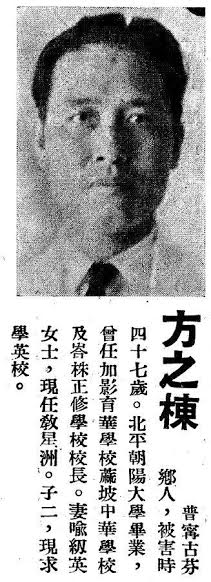
A short biography of Pang Chee Dong in the 8th anniversary commemorative publication of the Nanyang Pho Leng Hui Kuan published in 1948.
The fourth son Pang Huai Nam (方懷南) was the first editor of Nanyang Siang Pau (南洋商報) established by Tan Kah Kee in 1923. Slightly less than a month into its publication, he left the newspaper as the Straits Settlements authorities found his writing too political for their liking. He was also a committee member of the Poit Ip Huay Kuan and principal of Choon Guan School. It was mentioned in Phua Chay Leong’s “The Teochews in Malaya” that he shared the same sad fate as his elder brother Chee Dong during Sook Ching.
Mentioned as well in Mdm Chng’s obituary was one of her grandsons, Pang Say Hua (方思法). Born in Singapore to her eldest son, he was “fostered” to his uncle Pang Nam Gang; his father was convinced that his second brother would come to no good end with his revolutionary ways and hence it was better that he had a son to his name. Pang Say Hua went back to China to study and subsequently became a signaler in the Nationalist Army. He was one of the many caught up in the tumult of the times. Due to his background, he suffered after the Communists took over, being imprisoned for over ten years. After his release, he worked at various jobs and retired in 1980. His story became known when a civic organisation in the Teochew region which sought to recognize veterans of the Sino-Japanese War found him and publicised his story.
Single for life, he attended church regularly and spent his last days in a Christian old folks’ home where his favourite pastime was to watch Teochew opera. He died in Jan 2015, a month after he celebrated his 104th birthday.
Source: http://www.stcd.com.cn/html/2013-09/21/content_464908.htm
“Legally Yours”
(Sat 20 Jun’15 9am – 11.30am)
Join Fabian and Chyen Yee as they tell you more about the lives and wills of pioneers and how some of them tied up their fortunes in legal clauses to help counter an old Chinese saying that “fortune does not survive beyond 3 generations.
Meeting Point: Bukit Brown entrance gates at Lorong Halwa
—————————————————————————
Difficulty: Average, some trekking required
Please bring umbrella or poncho / sun block / mosquito repellent.
Please wear covered footwear.
Please note: Disclaimer: By agreeing to take this walking tour of Bukit Brown Cemetery, I understand and accept that I must be physically fit and able to do so.To the extent permissible by law, I agree to assume any and all risk of injury or bodily harm to myself and persons in my care (including child or ward)
Meeting point is within the cemetery, just beyond the gates of Bukit Brown as you enter on the left where the site offices are located.
Please register your attendance at Peatix and get a free ticket here
He was an old trustee of the Soon Thian Keing (Temple) who together with his wife is buried at Bukit Brown. Through his personal memories, Ho Siew Tien (1864-1960) helped shed light on the temple’s history.
This story by Ang Yik Han begins with the origins of one of the oldest temples in Singapore.
***************************************************************************************
In the 1980s, a debate took place in the local newspapers over the age of an old Chinese temple dedicated to the earth deity Tua Pek Kong in Malabar Street. Historians argued over an ambiguous phrase in one of the temple’s old stelae, which stated that the temple, the Soon Thian Keing (順天宮), was established during the years of the reigns of Jiaqing and Daoguang (“嘉道之際”). As the Jiaqing Emperor ruled from 1796 to 1820 and Daoguang from 1821 to 1850, proponents of an earlier dating for the temple argued that its establishment may have predated the founding of Singapore in 1819. However, there was no direct evidence to support this claim. No artefacts survived from the temple’s earliest days and the stele in question was erected only in 1902 when the temple was reconstructed.
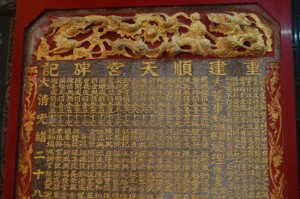
Part of the 1902 stele still preserved in the Soon Thian Keing today. It shows the main temple sponsors and major contributors to the temple’s building fund (photo Yik Han)
One the earliest known accounts of the Soon Thian Keing before its reconstruction was an interview given by one of its trustees, Ho Siew Tian (何秀填), in 1949. He recalled that when he first arrived in Singapore in 1882 at the age of 18, the temple was only a small shrine located next to a tree which housed the Tua Pek Kong statue. The shrine was refurbished by two merchants in 1888. It was only in 1902 (28th year of Guangxu’s reign) that some merchants based in the Sio Po area (the colloquial Chinese term for the part of town north of the Singapore River) came together to construct a proper building for the temple.
Other than getting a new building, the turn of the 20th century was significant for the temple for another reason. Some Hokkien merchants started a school in 1903 and then turned to the temple committee for funding to sustain the school. Thus began the decades long association between the temple and the Chung Cheng School (崇正学校) [not to be confused with Chung Cheng High (中正學校) which was managed by the Hokkien Association].
Every year, the temple provided for the school’s upkeep from the money paid by the resident monk who was contracted to run the temple. In 1916, a school for girls, the Chong Pun Girls School (崇本女校) was started and likewise funded by the temple. Committee members of the Soon Thian Keing sat on the boards of both schools. Prominent alumni members of the Chung Cheng School over the years included Lee Kong Chian and President Ong Teng Cheong.
As the number of students increased, the need for new premises for both schools was keenly felt. In 1938, the construction of a new school building at Aliwal Street was completed. This housed both the Chung Cheng School as well as the Chong Pun Girls School under one roof. It was recorded that Ho Siew Tian was a prime driver in the construction of the new school building along with the then temple chairman. A trustee of the Soon Thian Keing since 1933, he was concurrently the treasurer of the temple and the two schools, a position he held till after the war.
Hailed as one of the most modern Chinese school buildings of its day, the building has been preserved and is today the Aliwal Arts Centre.
As Aw Boon Haw donated substantial funds towards the building’s construction, the school hall was named after his company, Haw Par.
Old photos dating from 1950 which showed girls of Chong Pun exercising in the school field, today a carpark. Sultan Mosque can be seen in the background.
Ho Siew Tian ran a thriving hardware and building materials business under the chop Ho Hock Ann (何福安) at Beach Road. He also owned a number of twakows for transporting goods. As his wealth grew, he made substantial investments in properties. In 1948, he incorporated his firm as a limited company and handed over its running to his sons, who subsequently expanded the business to firearms.
It was urban redevelopment which spelled the end for the temple and the schools. In 1980s, the temple was acquired by the government for building the MRT. It moved successively to various temporary sites before its present building at Lorong 29 Geylang was completed. With the resettlement of the urban residents in the area, dwindling student enrolment led to the closure of Chung Cheng School in the 1980s as well. Its name was transferred to a primary school in Tampines.
Soon Thian Keing today in Lor 29 Geylang (photo Yik Han)
Ho Siew Tian is buried at Hill 4 together with his wife who died 12 years before him. According to obituaries in the Straits Times and the Singapore Free Press, he was one of the oldest men in Singapore at the point of his death at the age of 96. He was survived by 5 sons (2 other sons died before him), 3 daughters, 2 sons-in-law, 7 daughters-in-law, 81 grandchildren, 8 grand sons-in-law, 4 granddaughters-in-law and 37 great grandchildren.
Ang Kok Kian – A Pioneer of the Soap industry
by Ang Yik Han
It is not clear if Ang Kok Kian (洪轂堅) grew up in Penang or he travelled there from his ancestral village in Nan’an county, Fujian province. During the 1910s, he moved to Taiping with his family but left after two years for Singapore, where he felt there were better prospects.
Of the businesses he established in Singapore, the most successful was the See Sen Soap Factory (時鮮肥皂廠), one of the local firms which rose to challenge the dominance of the market by Western manufacturers then. Although sales trailed behind another local firm Ho Hong Soap Factory, its distinctive “Dog’s Head” (狗頭標) brand soap was popular in Singapore, Malaya, Borneo and Hong Kong, both before and after the war.

Dog Brand Trade Mark (Source https://moulmeincacc.wordpress.com/2014/06/03/castle-at-no-19-barker-road/)
Ang Kok Kian passed away in 1939, leaving behind 4 sons. By then, his eldest son Ang Hai Sun (洪海山) was actively involved in the family business. Not content with expanding the soap factory, he went into oil milling to ensure a stable supply of raw materials for the factory.
Although “Dog’s Head” soap has disappeared from the market for decades, the mark of this locally produced soap can still be seen today adorning the house which Ang Hai Sun built, where his descendants still reside.
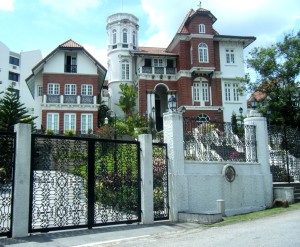
Home of the present descendants of Ang Kok Kian (source https://moulmeincacc.wordpress.com/2014/06/03/castle-at-no-19-barker-road/)
More information on his descendants here
Double tomb of Ang Kok Kian and his wife at Bukit Brown Hill 4
We kicked off the first Bukit Brown Tour & Clean-Up Corporate Social Responsibility (CSR) event of 2015 on 16 May 2015 with a record number of 50+ volunteers. The volunteer sign-ups were overwhelming and the organizing team had to cap the group size due to logistical limitations.
Heritage preservation is certainly a CSR theme that is catching on at Standard Chartered Bank! Read on to find out what one of our volunteers experienced…
By Hemanshu Parekh
(photo credit : compilation of StanChart & All Things Bukit Brown)
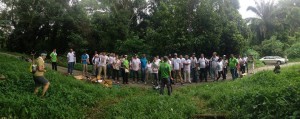
Pictured: Supported by 35 volunteers when this initiative first started out in 2014, the Bukit Brown Tour & Clean-Up effort is seeing growing interest from Bank staff and has hit a record of 50+ volunteers at the fourth session held on 16 May 2015.
New to this event, most of the volunteers signed up for this event not knowing what to expect. At the end of the day, it turned out to be one of the most rewarding and satisfying CSR effort we have ever experienced!
The day started with volunteers assembling at the gates of Bukit Brown Cemetery, which was also the starting point of our tour of the heritage site. We were split in 2 groups – newbies and repeat volunteers. While repeat volunteers were taken on a tour route that included the nearby kampong (village), newbies like myself went on an “orientation” route, with Catherine as our guide.
Catherine – like all other guides –is a ’Brownie’ who is dedicated to conservation work and conducting tours for Bukit Brown. ’Brownies‘ have been investing their weekends on this project for over 3 years now.
Catherine started the session by giving us basic education on the cemetery and Chinese tombs.
The layout of Bukit Brown Cemetery, first followed a grid system, meticulously drawn by the British for the Chinese during colonial times. The cemetery is known as the “mother cemetery” as it also hosts the graves from other cemeteries which have been taken over by development.
As the resting place of many pioneers of Singapore, some of the bigger and elaborate tombs hold tremendously historical value, particularly since many Chinese tombs in China were destroyed during the Cultural Revolution.
The Chinese did not like the structured grid pattern laid down by the British, as that did not conform to the all-important Feng Shui or geomancy considerations for burial, such as elevation, the presence of water bodies, the direction the tomb faces, etc. Obviously, the stature and wealth of the deceased would determine whether the tomb could incorporate all the desirable Feng Shui elements. Historians have noted that while the initial tombs are laid out in a structured pattern, subsequent ones had more generous layouts – obviously Feng Shui took precedence over orderliness.
Standing beside a tomb, Catherine proceeded to explain the layout of typical Chinese tombs. The tombstones of Chinese tombs were actually the foot stones. At burial, the body was slightly elevated such that the head was higher than the feet. Tombs belonging to the Hokkiens, were constructed in a rounded shape so as to resemble a tortoise – which has positive Feng Shui connotations.
Granite was the most commonly used stones for constructing tombs, and they were sometimes imported from China for the purpose. Marble stones were also used at times.
Couple tombs always had the husband positioned on left and wife on the right. A pair of lion statues was usually installed as tomb guardians, where male lions were depicted with a foot standing on a ball, while female lions had a cub by its side. The “gender” positioning for tombs are male always on the left and female are always, right. The plot for tomb had to be purchased in advance and would cost about Straits$ 6 – 30 per plot in 1924.
As Singapore became an important trading port where many cultures intersect, some Chinese tombs incorporated non-Chinese cultural elements. Some tombs emulated aesthetic practices of the British like the use of decorative tiling. In the later years, tiles were imported from Japan and bore Asian- inspired designs –European tiles used abstract designs while Asian tiles featured auspicious motifs like flowers and fruits.
When we stopped by a majestic hill tomb, Millie, another guide, took over the story telling. This was her great grandfather’s resting place. About 4 years ago, she learnt that her great grandfather was laid to rest in Bukit Brown. She spent time researching his tomb and eventually located it in the vast cemetery. She then spent time restoring the tomb, which was overgrown with vegetation.
Her story is not an unique one – in recent years, a number of people have located the tombs of their ancestors through research and search, restored dignity to the forgotten tombs, reunited the living with the deceased and uncovered intriguing stories of the past. Often, the experience of locating one’s ancestors’ tomb is an emotional one. The amalgamation of numerous personal stories and anecdotes form a deep historical narrative for the heritage cemetery.
We saw another tomb where turban clad Sikhs statues took the place of the typical lion guardians. Years ago, one of the traditional professions that Sikhs took on was that of policemen and guards to the wealthy – and they were revered for their bravery and dependability. Hence, the erection of Sikh guardian statues was a way of paying homage to the Sikhs professionalism. There are to date 26 pairs of Sikh guardians found in Bukit Brown cemetery.
We came across a few tombs which had various mythical creatures as tomb guardians. We were told that in China, there were strict rules governing the use of mythical creatures as tomb guardians as they were reserved for government officials or even royalty. As the Chinese saying that goes “Far from the Emperor, Far from Judgment” – the Chinese in Singapore had the liberty of flaunting these rules without fearing the Emperor’s wrath.
The tour lasted almost one hour and ended at a clearing where an array of equipment were neatly laid on the grass for the second part of the event – tomb cleaning.
After a comprehensive safety briefing, we were split into 5 teams of 10 volunteers. The teams were tasked with different duties: 2 teams were assigned to heavy duty tomb cleaning work, which involved clearing dense overgrowth and tree cutting; 2 teams were tasked with clearing and cleaning tombs with moderate undergrowth; and one team was to pick up rubbish along the trails. I volunteered for the heavy duty work.
My team was tasked with cleaning the neglected tombs in the Cheang Hong Lim family cluster. There were a total of 8 tombs and half of them were almost completely covered by undergrowth, shrubs and small trees.
The task seemed daunting at first and the undergrowth was very thick, oftentimes colonised by unfriendly red ants. We gritted our teeth, picked up our equipment and started work under the guidance of veteran volunteers. After a while, we got the hang of the work, and progressed faster.
The first sense of satisfaction came when we hit concrete and uncovered the forecourt of the first tomb we worked on. After that, it became a drill: cut the shrubs and trees, clear the undergrowth, find the forecourt, then clear the vegetation off the forecourt and tombstone.
Teamwork was the order of the day, as we alternated between the tasks of cutting, cleaning and disposing of debris.
We were drenched in sweat and hard at work when we were told we had only 10 minutes left – time really went by quickly when you are engrossed in work! Not wanting to do slipshod work on the few remaining tombs, we doubled up our efforts like schoolboys during the last 10 minutes of their exams.
When we were done, we high-fived one another and admired our work with a strong sense of achievement and satisfaction. We took group photos and shared smiles and cheers with fellow volunteers and the Brownies. Some volunteers claimed that this was the most challenging and satisfying CSR ever. Most of us agreed it was definitely a unique, educational and satisfying experience!
We reached the end of the official activities and most volunteers left. A handful of us, who had not had enough, decided to take a final tour to the famous Ong Sam Leong tomb, reputed to be the biggest and most majestic in Bukit Brown. We reached the tomb after a 15 minute hike up a hill. The size of ten 3-bedroom HDB flats, it truly was a majestic tomb. The tomb belonged to yesteryear phosphate magnet Ong Sam Leong’s family. It was constructed with high quality granite, adorned with numerous intricate carvings (the stories behind the carvings could easily fill a book), and it even had a moat where once contained fishes! Our guide Claire highlighted that this is the only tomb that can be seen from Goggle Earth.
The day ended with us being a little more educated on history and exhausted from the laborious morning. Besides leaving with a tremendous sense of satisfaction for our heritage preservation work, I’m sure we also left with the blessings of the many pioneers resting on Bukit Brown!
********************************
All Things Bukit Brown and the Brownie volunteers would like to say a huge “thank you” to the Stanchart crew for their heart and hard work.
Researched by Ang Yik Han
Died in the year of the Horse, 19 July 1942 and survived by one son named Kah Bo (嘉謀), Hou Xiu Xi ( 侯秀西 )located at Hill 1 was said to be a good orator and a staunch supporter of the China Relief Fund led by Tan Kah Kee.
He spoke at public rallies and occasions such as temple celebrations to exhort the local Chinese to support the anti-Japanese cause. According to an account, he was beaten to death during the Japanese Occupation for refusing to cooperate with the Japanese authorities.
It’s All Things Peranakan for this guided walk in a nod to the exhibition at the Peranakan Museum’s exhibition on “Great Peranakans”
Join Catherine and Bianca as they take you to tombs of well known Peranankans and not so well known.
Known as the “King’s Chinese”, the Peranakans straddled the challenges of twin loyalties to their ancestral roots and their colonial masters, expressed in the” fusion” or some might argue the “confusion” of their customs, traditions and thinking and what emerges is a unique culture which still have experts debating just what makes one a Peranakan?
But rising above the debate, there is no doubt, they led remarkable lives and their contributions to the political and social landscape of Singapore and the region have earned them a place in history, and a place in Bukit Brown which is also known as The Peranakan Cemetery.
This guided walk starts at 4.00pm and ends at 6.30pm
Please note: Disclaimer: By agreeing to take this walking tour of Bukit Brown Cemetery, I understand and accept that I must be physically fit and able to do so.To the extent permissible by law, I agree to assume any and all risk of injury or bodily harm to myself and persons in my care (including child or ward)
Meeting point is within the cemetery, just beyond the gates of Bukit Brown as you enter on the left where the site offices are located.
Please register at Peatix.
Places available are capped at 30 for better engagement.
—————————————————————————
Difficulty: Average, some trekking required
Please bring umbrella or poncho / sun block / mosquito repellent.
Please wear covered footwear.

The tomb of Tan Boo Liat, great grandson of Tan Tock Seng, sketcher is Stella Kon, great granddaughter of Tan Boo Liat (photo: Catherine Lim)
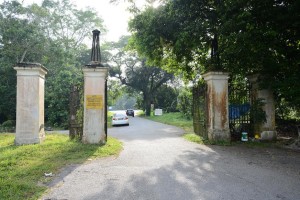






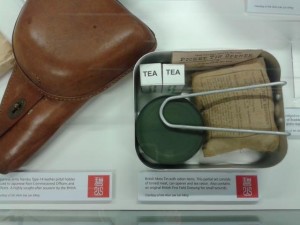

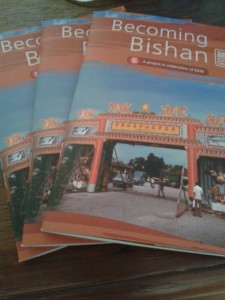
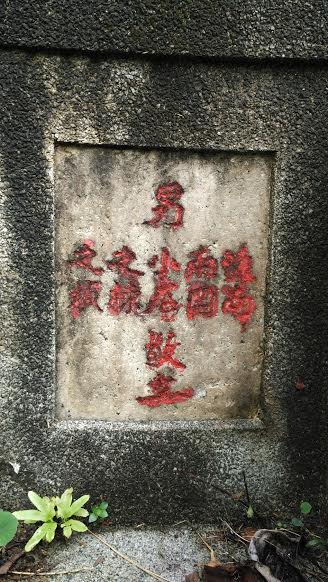



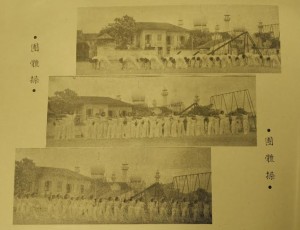
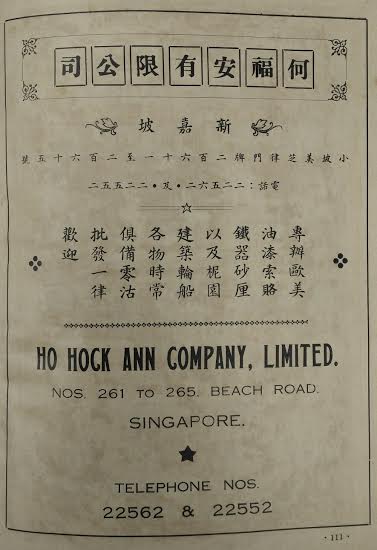

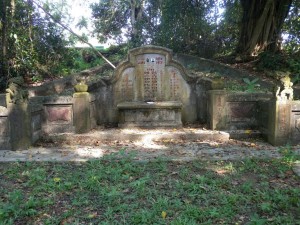

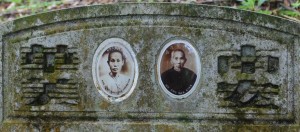

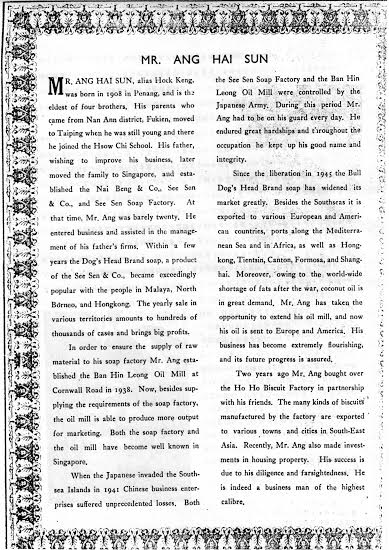
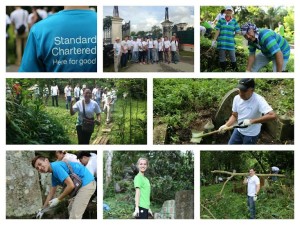
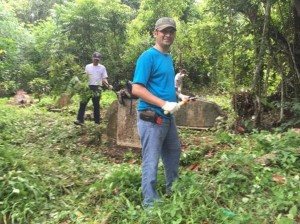
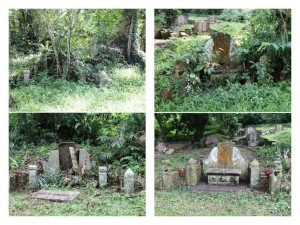
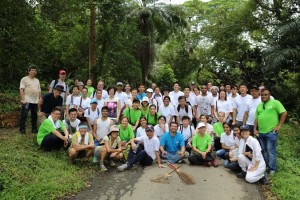

Recent Comments